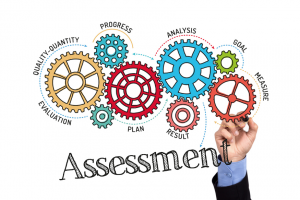
There are over 3,000 assessment tools on the market today. The challenge? Most do not meet the minimum standards set by the Department of Labor for preemployment and selection use.
Why is this important to know?
Many applicants have been well trained on how to be interviewed and how to answer frequently asked questions. They know how to say the right things, make promises you want to hear, and provide great work samples. However, these conversations do not accurately predict what the person can and may do on the job in your company.
Qualified assessments provide objective data and information that most job candidates won’t tell you and may not even realize.
As a potential employer, you only see 10% of the person based on the quality of the resume, interviews, and reference checks. But, if you are like most interviewers, you make many assumptions about the job candidates’ suitability for the job.
What’s missing? Objective data! The 90% that is hidden will provide you predictive information on whether they can and will do the job and do it successfully in your company. Objective data includes qualified job fit assessments, in addition to a well-structured interview and thorough due diligence.
The purpose of using qualified job fit assessments is to get real about the applicant’s fit with the job responsibilities. Jeannette Seibly
What types of qualified assessments predict a candidate’s success on the job?
- Thinking Style (Can they do the job?)
- Interests/Motivations (Will they do the job?)
- Behavioral Traits (Can they do the job here?)
- Job Matching (Will they fit successfully in the position?)
The benefits of qualified assessments:
- Provide the highest level of valid and reliable information due to thorough research.
- Predict success in a specific job.
- Provide a technical manual* for your review.
- Verify or contradict your “gut/intuition.”
- Prevent “biases” from getting in the way.
- Are tested to be nondiscriminatory.
- Help you meet all federal, state, and local statutes. (For international candidates, check with that country’s requirements.)
- Validate the quality of information the candidate is providing: Is it accurate, or what they think you want, or what they wish they were … or a mix of all three?
- Used as directed, they work!
*The first step when selecting a qualified job fit assessment is to review the Technical Manual.
To ensure each assessment tool is valid and reliable for preemployment and selection purposes, request a technical manual from the publisher or vendor for the assessment product.
A technical manual documents the research and development required to meet the Department of Labor (DOL) Guidelines (Testing and Assessment: An Employer’s Guide to Good Practices), Equal Employment Opportunity (EEO), Americans with Disability Act (ADA), and other requirements for the assessment to be used for preemployment and selection purposes. It helps you determine if the assessment meets minimum validity and reliability requirements for use in your specific employment location(s).
Beware: some vendors may provide a letter from their attorney stating the assessment meets all applicable laws for hiring and selection purposes. That letter protects them, not you. Do your homework!
So, what questions help determine validity and reliability of a qualified assessment?
The following questions are not inclusive when deciding which assessment to use. These are suggestions to get you started.
- Does it assess job-related skills?
- Does it meet all legal requirements for your work locations?
- Does it have recent validity and reliability tests?
- Does it provide predictive validity, high enough to meet DOL standards?
- What are the sample sizes and makeup for those tests (e.g., Is it validated with a large sample of working people, or a small sample of college sophomores)?
- Is it appropriate for preemployment selection and hiring purposes?
- Are you planning to use it for its intended purpose?
Note: Just because an assessment is being used for training or coaching purposes and shows differences in people, does not mean that it can be used for preemployment and selection purposes. Not only is using the correct assessment of legal importance, but it also ensures that you are using tools with the validity and reliability required to accurately and objectively measure the person for the job.
Content for this article is taken from: Hire Amazing Employees: How to Increase Retention, Revenues and Results!
©Jeannette Seibly 2022 All Rights Reserved
 Jeannette Seibly is The Leadership Results Coach. She has been an award-winning international executive and family business management consultant, keynote speaker, and author for over 29 years. Her focus is to guide leaders to make a positive difference. Feel stuck moving your team forward? Want straightforward counsel on how to do it? Let’s chat! Contact Jeannette for a confidential conversation.
Jeannette Seibly is The Leadership Results Coach. She has been an award-winning international executive and family business management consultant, keynote speaker, and author for over 29 years. Her focus is to guide leaders to make a positive difference. Feel stuck moving your team forward? Want straightforward counsel on how to do it? Let’s chat! Contact Jeannette for a confidential conversation.
A note from Jeannette about why preemployment assessments are a must: There are over 3,000 assessments on the market today. Most do NOT meet the Department of Labor’s minimum standards when using them for preemployment and selection purposes. So, what do you need to know, and how do you select the right ones? The information in this article is taken from the newly published book, Hire Amazing Employees: How to Increase Retention, Revenues and Results! Have questions? Most do! Let’s chat now!
Are your job candidates saying, “I didn’t get the job! But I dodged a toxic boss!”? If yes, your hiring process needs help immediately! Grab your copy of newly released Hire Amazing Employees: How to Increase Retention, Revenues and Results!


 Jeannette Seibly is The Leadership Results Coach. She has been an award-winning international executive and family business management consultant, keynote speaker, and author for over 29 years. Her focus is to guide leaders to make a positive difference. Feel stuck moving your team forward? Want straightforward counsel on how to do it? Let’s chat!
Jeannette Seibly is The Leadership Results Coach. She has been an award-winning international executive and family business management consultant, keynote speaker, and author for over 29 years. Her focus is to guide leaders to make a positive difference. Feel stuck moving your team forward? Want straightforward counsel on how to do it? Let’s chat! 
 Jeannette Seibly is The Leadership Results Coach. She has been an award-winning international executive and family business management consultant, keynote speaker, and author for over 29 years. Her focus is to guide leaders to make a positive difference. Feel stuck moving your team forward? Want straightforward counsel on how to do it? Let’s chat!
Jeannette Seibly is The Leadership Results Coach. She has been an award-winning international executive and family business management consultant, keynote speaker, and author for over 29 years. Her focus is to guide leaders to make a positive difference. Feel stuck moving your team forward? Want straightforward counsel on how to do it? Let’s chat! 





